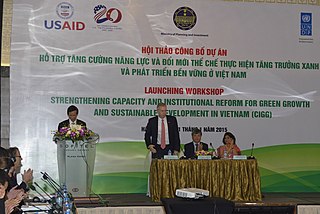E-government is the use of technological communications devices, such as computers and the Internet, to provide public services to citizens and other persons in a country or region. E-government offers new opportunities for more direct and convenient citizen access to government and for government provision of services directly to citizens.
Good governance is the process of measuring how public institutions conduct public affairs and manage public resources and guarantee the realization of human rights in a manner essentially free of abuse and corruption and with due regard for the rule of law. Governance is "the process of decision-making and the process by which decisions are implemented ". Governance in this context can apply to corporate, international, national, or local governance as well as the interactions between other sectors of society.
A public–private partnership is a long-term arrangement between a government and private sector institutions. Typically, it involves private capital financing government projects and services up-front, and then drawing revenues from taxpayers and/or users for profit over the course of the PPP contract. Public–private partnerships have been implemented in multiple countries and are primarily used for infrastructure projects. Although they are not necessary, PPPs have been employed for building, equipping, operating and maintaining schools, hospitals, transport systems, and water and sewerage systems.

As a field of study, public administration is the sub-field of political science that studies the structures, functions, and behavior of public institutions.
Governance is the process of making and enforcing decisions within an organization or society. It encompasses decision-making, rule-setting, and enforcement mechanisms to guide the functioning of an organization or society. Effective governance is essential for maintaining order, achieving objectives, and addressing the needs of the community or members within the organization. Furthermore, effective governance promotes transparency, fosters trust among stakeholders, and adapts to changing circumstances, ensuring the organization or society remains responsive and resilient in achieving its goals. It is the process of interactions through the laws, social norms, power or language as structured in communication of an organized society over a social system. It is done by the government of a state, by a market, or by a network. It is the process of choosing the right course among the actors involved in a collective problem that leads to the creation, reinforcement, or reproduction of acceptable conduct and social order". In lay terms, it could be described as the processes that exist in and between formal institutions.
Electronic governance or e-governance is the application of information technology for delivering government services, exchange of information, communication transactions, integration of various stand-alone systems between government to citizen (G2C), government-to-business (G2B), government-to-government (G2G), government-to-employees (G2E) as well as back-office processes and interactions within the entire governance framework. Using e-governance, government services are made available to citizens through IT. The three main target groups that can be distinguished in governance concepts are government, citizens, and businesses/interest groups.

Capacity building is the improvement in an individual's or organization's facility "to produce, perform or deploy". The terms capacity building and capacity development have often been used interchangeably, although a publication by OECD-DAC stated in 2006 that capacity development was the preferable term. Since the 1950s, international organizations, governments, non-governmental organizations (NGOs) and communities use the concept of capacity building as part of "social and economic development" in national and subnational plans. The United Nations Development Programme defines itself by "capacity development" in the sense of "'how UNDP works" to fulfill its mission. The UN system applies it in almost every sector, including several of the Sustainable Development Goals to be achieved by 2030. For example, the Sustainable Development Goal 17 advocates for enhanced international support for capacity building in developing countries to support national plans to implement the 2030 Agenda.
The Deutsche Gesellschaft für Internationale Zusammenarbeit (GIZ) GmbH, often simply shortened to GIZ, is the main German development agency. It is headquartered in Bonn and Eschborn and provides services in the field of international development cooperation and international education work. The organization's self-declared goal is to deliver effective solutions that offer people better prospects and sustainably improve their living conditions.
Public administration theory refers to the study and analysis of the principles, concepts, and models that guide the practice of public administration. It provides a framework for understanding the complexities and challenges of managing public organizations and implementing public policies.
The first idea of a digital administrative law was born in Italy in 1978 by Giovanni Duni and was developed in 1991 with the name teleadministration.
The Governance and Anti-Corruption Country Diagnostics is a survey tool, which uses information gathered from in-depth, country-specific surveys of households, businesses, and public officials about institutional vulnerabilities. The tool is used by the World Bank and partner governments to measure and evaluate critical governance challenges within the public sector.
Governance is a broader concept than government and also includes the roles played by the community sector and the private sector in managing and planning countries, regions and cities. Collaborative governance involves the government, community and private sectors communicating with each other and working together to achieve more than any one sector could achieve on its own. Ansell and Gash (2008) have explored the conditions required for effective collaborative governance. They say "The ultimate goal is to develop a contingency approach of collaboration that can highlight conditions under which collaborative governance will be more or less effective as an approach to policy making and public management" Collaborative governance covers both the informal and formal relationships in problem solving and decision-making. Conventional government policy processes can be embedded in wider policy processes by facilitating collaboration between the public, private and community sectors. Collaborative Governance requires three things, namely: support; leadership; and a forum. The support identifies the policy problem to be fixed. The leadership gathers the sectors into a forum. Then, the members of the forum collaborate to develop policies, solutions and answers.

Anthony Cheung Bing-leung, GBS, JP is a Hong Kong politician and academic. He was the Secretary for Transport and Housing from 2012 to 2017 and 5th President of the Hong Kong Institute of Education (HKIEd). He was one of the few government officials coming from a pro-democracy background.
Civil service reform is a deliberate action to improve the efficiency, effectiveness, professionalism, representativity and democratic character of a civil service, with a view to promoting better delivery of public goods and services, with increased accountability. Such actions can include data gathering and analysis, organizational restructuring, improving human resource management and training, enhancing pay and benefits while assuring sustainability under overall fiscal constraints, and strengthening measures for performance management, public participation, transparency, and combating corruption.

A one-stop shop (OSS), in public administration, is a government office where multiple services are offered, allowing customers to access these services in a centralized location rather than in different places.
The Sustainable Governance Indicators (SGI), first published in spring 2009 and updated in 2011, analyze and compare the need for reform in Organisation for Economic Co-operation and Development (OECD) member countries, as well as each country's ability to respond to current social and political challenges. The project is designed to create a comprehensive data pool on government-related activities in the countries considered the world's most developed free-market democracies. In addition, it uses international comparisons to provide evidence-based input for reform-related public discourse taking place in these countries. The SGI are updated every two or three years.

Corruption in Georgia had been an issue in the post-Soviet decades. Before the 2003 Rose Revolution, according to Foreign Policy, Georgia was among the most corrupt nations in Eurasia. The level of corruption abated dramatically, however, after the revolution. In 2010, Transparency International (TI) said that Georgia was "the best corruption-buster in the world." While low-level corruption had earlier been largely eliminated, Transparency International Georgia since 2020 has also documented dozens of cases of high-level corruption that remain to be prosecuted.

The Institute for Development of Freedom of Information (IDFI) - is a Georgian non-governmental organization which tends to support the development of an informed and empowered society for democratic governance. IDFI promotes human rights and good governance by raising civic awareness through sound informational reports, research and recommendations; Advocates for initiating & implementing reforms of policies, laws and practices to enhance democratic governance.
Whole-of-Government Approach (“WGA”) refers to the joint activities performed by diverse ministries, public administrations and public agencies in order to provide a common solution to particular problems or issues.




